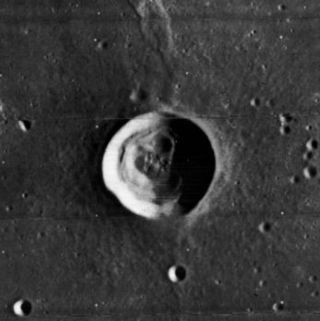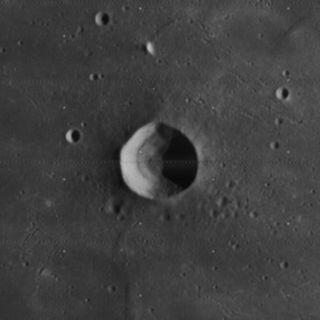
Archimedes is a large lunar impact crater on the eastern edges of the Mare Imbrium. Its diameter is 81 km.

Carlini is a small lunar impact crater located in the Mare Imbrium. It was named after Italian astronomer Francesco Carlini. The crater is bowl-shaped with a small central floor. It has a higher albedo than the surrounding mare, making it prominent due to its isolated location. To the south is a wrinkle ridge named Dorsum Zirkel, and farther south lies the peak Mons La Hire.

Caventou is a tiny lunar impact crater located in the western part of the Mare Imbrium. It is a circular, cup-shaped formation surrounded by the lunar mare. It was named after French chemist Joseph B. Caventou in 1976. Prior to that, it had the designation La Hire D, being associated with the mountain Mons La Hire to the southeast.

Draper is a small lunar impact crater in the southern part of the Mare Imbrium. It is a circular, cup-shaped formation, with a tiny craterlet intruding into the northeastern rim. To the north-northeast is the crater Pytheas, and to the south lies the Montes Carpatus range. Just to the southeast is the slightly smaller crater identified as Draper C. The crater is named after American astronomer Henry Draper.

Huxley is a tiny lunar impact crater located in eastern inlet of Mare Imbrium, just to the north of the Montes Apenninus. It was named after British biologist Thomas Henry Huxley. To the southeast in this range is Mons Ampère. This crater was previously identified as Wallace B before being renamed by the IAU. The crater Wallace lies due west.

Aratus is a small lunar impact crater located on the highland to the south and east of the rugged Montes Apenninus range. It is a circular, cup-shaped crater with a relatively high albedo. It was named after Greek astronomer Aratus of Soli. To the east is the Mare Serenitatis, and to the southwest is the somewhat larger crater Conon. North-northeast of Aratus is the landing site of the Apollo 15 mission, just beyond Mons Hadley Delta.

C. Herschel is a small lunar impact crater that lies on the western part of Mare Imbrium. It is named after German astronomer Caroline Herschel. It is a circular, bowl-shaped formation that has not undergone significant erosion. The interior floor has the same low albedo as the surrounding lunar mare. To the south-southwest is the similar crater Heis. C. Herschel lies on a wrinkle ridge of the lunar mare named the Dorsum Heim.

Joy is a small lunar impact crater located in the irregular ground just to the west of Mare Serenitatis. It is a circular, cup-shaped feature with a slightly raised rim.

Delisle is a small lunar impact crater in the western part of the Mare Imbrium. It was named after French astronomer Joseph-Nicolas Delisle. It lies to the north of the crater Diophantus, and just to the northwest of the ridge designated Mons Delisle. Between Delisle and Diophantus is a sinuous rille named Rima Diophantus, with a diameter of 150 km. To the northeast is another rille designated Rima Delisle, named after this crater.

Drude is a lunar impact crater that lies on the far side of the Moon, in the rugged Montes Cordillera range that forms the outer ring around the Mare Orientale impact basin. It is located just behind the west-southwest limb, and this area is sometimes brought into sight from Earth during favorable librations. However, even at such times, the crater is viewed from the edge and little detail can be seen.

Yangelʹ is a small lunar impact crater that is located in the irregular terrain to the north of the Mare Vaporum. Its diameter is 8 km. It was named after Soviet rocketry scientist Mikhail Kuzmich Yangelʹ in 1973. This crater was formerly designated Manilius F.

Wolf is a lunar impact crater that lies in the south-central part of the Mare Nubium, a lunar mare in the southern hemisphere of the Moon. It lies to the north-northwest of the walled plain Pitatus, and east-southeast of the prominent crater Bullialdus. It is named after the German astronomer Max Wolf.

Feuillée is a small lunar impact crater in the eastern part of the Mare Imbrium. It was named after French natural scientist Louis Feuillée. It lies less than a half crater diameter to the northwest of Beer, and the two formations form a nearly matched pair. To the west is the small but prominent crater Timocharis.

Kirch is a small lunar impact crater in the eastern part of the Mare Imbrium, a large lunar mare in the northwest quadrant of the Moon. It was named after German astronomer Gottfried Kirch. This is a relatively solitary formation with the nearest comparable crater being Piazzi Smyth to the northeast. Notable features in the vicinity are the Montes Spitzbergen mountains to the south and the solitary peak Mons Piton to the east-northeast. Kirch is circular and bowl-shaped, with a dark interior having the same albedo as the surrounding terrain.

Bliss is small lunar impact crater that is located just to the west of the dark-floored crater Plato. It lies in a region of continental terrain between Mare Imbrium to the south and Mare Frigoris to the north. This crater is bowl-shaped, with a small interior floor at the midpoint and a somewhat eroded outer rim.

Mons Hadley is a massif in the northern portion of the Montes Apenninus, a range in the northern hemisphere of the Moon. It has a height of 4.5 km (2.8 mi) 14,764 ft (4,500 m) above the adjacent plain and a maximum diameter of 25 km at the base.

Mons Vinogradov is a rugged massif that is located on the lunar mare where Oceanus Procellarum to the southwest joins Mare Imbrium to the east. There are three primary peaks in this formation, which rise to altitudes of 1.0–1.4 km above the surface. To the east of this rise is the crater Euler, and to the southeast is an area of rugged ground that reaches the Montes Carpatus range. The Carpatus mountain range forms the southwest boundary of the Mare Imbrium.

Mons Bradley is a lunar mountain massif in the Montes Apenninus range, along the eastern edge of the Mare Imbrium. It is located to the west of the crater Conon. To the west of this peak is the Rima Bradley rille.

Mons Hadley Delta (δ) is a massif in the northern portion of the Montes Apenninus, a range in the northern hemisphere of the Moon adjacent to Mare Imbrium. It has a height of 3.6 km above the plains to the north and west.

Cassini is a lunar impact crater that is located in the Palus Nebularum, at the eastern end of Mare Imbrium. The crater was named after astronomers Giovanni Cassini and Jacques Cassini. To the northeast is the Promontorium Agassiz, the southern tip of the Montes Alpes mountain range. South by south-east of Cassini is the crater Theaetetus. To the northwest is the lone peak Mons Piton.




















